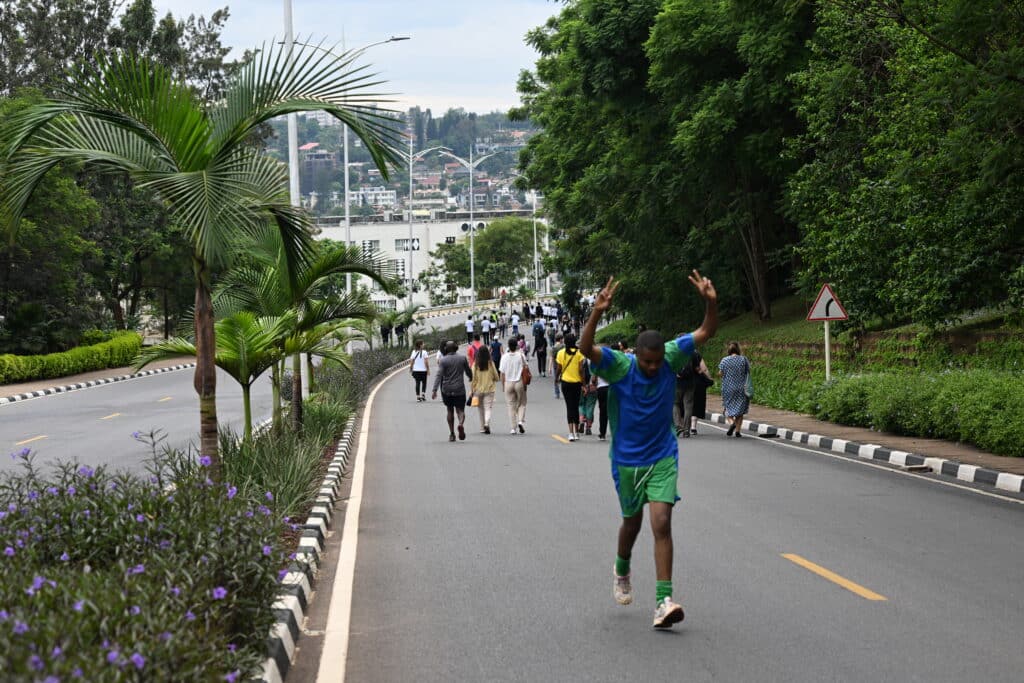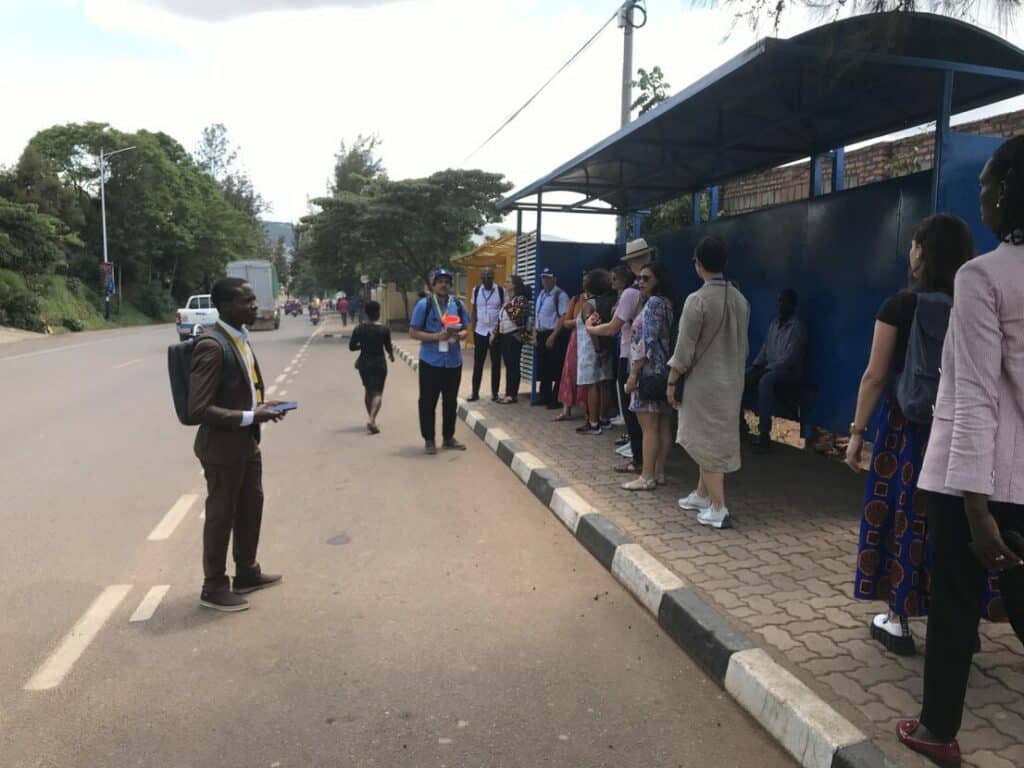In this era of transformation, cities are finally prioritizing walking and cycling in urban planning, local and national budgets, and for potential investors. This long-overdue change paves the way for a healthier, greener, safer, and more efficient future of urban transport.
Authored by: Constant Cap (UNEP), Mathias Merforth (GIZ), Juliet Rita (Walk21 Foundation-ANWAC), Janene Tuniz (UNEP)
Part 1: Strategies and Tools for Financing Walking and Cycling Initiatives
Collaborative Efforts to Support Sustainable Transport Financing
In the fast-paced urban world, it’s easy to underestimate the profound impact of simple solutions like walking and cycling, to complex transport challenges. Despite their crucial role in the daily mobility of most people, these modes of transportation are often overlooked by leaders and policymakers, particularly in African cities. Juliet Rita, the network coordinator of the Africa Network for Walking and Cycling (ANWAC), is determined to change this perspective.
As part of ANWAC, an initiative of the UN Environment Programme (UNEP) and the Walk21 Foundation, Juliet’s mission is to quantify and highlight the numerous benefits of walking and cycling. These benefits encompass reducing pollution and congestion, enhancing road safety, promoting physical health and strengthening community ties. This mission is critical for the future of transportation but comes with its own set of challenges.
A significant obstacle is the lack of data and dedicated budgets for walking and cycling initiatives. Network members understand that robust funding is essential for policy initiatives to reach their full potential. To address this challenge, ANWAC and UNEP are developing a comprehensive financing guide for African cities, intended to help decision-makers overcome the barriers that have hindered the development of complete and comprehensive walking and cycling infrastructure.
A Menu of Interventions
Within the realm of promoting walking and cycling, various interventions can be tailored to the unique challenges and budget constraints faced by cities. At the lower-cost end, initiatives like organizing car-free days, implementing temporary walking and cycling measures, conducting neighbourhood interventions, and prioritizing road safety improvements can be undertaken. These cost-effective interventions serve as a foundation for more extensive changes in the future.

People walking in Kigali during car-free days that occurs every 2nd Sunday of the month. © Sepa Sama
Strategic and medium-cost interventions involve a more structured approach, incorporating regulatory measures, such as managing vehicle access. These strategies also focus on harnessing land value capture, expanding sidewalks, and facilitating the development of shared cycling and walking paths. Research indicates that walking and cycling projects can increase land value by 70-300% [1]. Shared development investment models can use locally available raw materials for constructing cycling and walking paths, ensuring efficient budget utilization.
For instance, Colombia laid the legal groundwork for land value capture instruments in 1997, enabling Bogota to raise $350 million in 2007 through betterment levies. This revenue funded comprehensive street and urban space upgrades, including pavements and cycling tracks. The levy was paid by over 1.2 million landowners who enjoyed the improved infrastructure, so the per-owner contributions were kept relatively low. Remaining funds sourced from the public budget and loans. [2]

Bus stops are the business card of our cities and require investment – safe crossings, light and shade and a good sense of security define the attractiveness for users © TUMI
High-cost interventions include measures such as establishing a complete network of segregated paths for pedestrians and cyclists, implementing vehicle tax reforms, and introducing specific highway codes and road design structures to enhance safety, accessibility, and adapt infrastructures to climate change. While these interventions have the most significant impact, they require significant financial commitments.
Tools such as the Health Economic Assessment Tool (HEAT) and the Non-Motorized Transport Project Assessment Tool (NMT-PAT) are invaluable resources for making informed decisions about the most impactful interventions. They allow cities to assess the health and economic impacts of various transportation options, making a compelling case for investing in walking and cycling infrastructure.
Part 2: Local Commitment to Sustainable Financing
Showcasing Funding Success Stories and Challenges
Several trailblazers’ cities offer hope to walking and cycling enthusiasts. According to ITDP India, over the past five years, cities like Pune, Nagpur, and Ahmadabad have established dedicated budgets for sustainable transport. Their unwavering commitment is driven by a combination of factors that provide valuable lessons for urban planners and decision-makers worldwide.
Pune’s walking policy in 2016 [3] mandated the allocation of specific funds for pedestrian pathways. Additionally, the Pune Bicycling Plan emphasized the importance of financial provisions. However, what sets these cities apart is their unwavering support from their local leadership. Their belief in the necessity of robust walking and cycling infrastructure transcends political changes, providing stability and direction to sustainable transport efforts.
“Walking is a fundamental right of citizens and everyone is a pedestrian at one time or the other.”
Policy for Pedestrian Facilities and Safety in Pune City
In Windhoek, Namibia, despite recognizing the need for walking and cycling infrastructure in the Sustainable Urban Transport Master Plan[4] and the Non-Motorized Transport Strategy[5], budget constraints remain a significant challenge. However, as of 2023, the country has the opportunity to secure combined funding from the national government, city funds, and the German development bank KfW.
In response to funding constraints, innovative financing approaches are emerging as potential solutions. Surat in India demonstrates how funds from national government were harnessed to create more than 75 kilometers of cycling lanes. Nairobi, Kenya, is also making commendable strides by allocating up to 20% of its transport budget to developing walking and cycling infrastructure. This financial commitment aligns with sustainability, climate targets, and Sustainable Development Goals.
Part 3: Financing Sustainable Urban Transport – A Comprehensive Approach
Principles and Practical Examples for Financial Sustainability
To establish a seamless and sustainable urban transport system, integrating walking, cycling, and public transportation is crucial not only for multimodal connectivity but also for harnessing synergies for financial success. Mathias Merforth, a transport economist from GIZ, provides valuable insights into this transformation:
Many African cities accelerating up the development of urgently needed high-capacity public transport systems like bus rapid transit (BRT) or rail-based systems. However, until these networks span across African metropolis, many commuters will need patience before being able to fully use these new mobility options. Till then, many potential passengers will live too far from the next station, so that feeder (bus) services become necessary. However, this is not only costly for the operators but often comes with additional costs for the traveller due to the fragmented ticketing system. [6]
Walking, often overlooked as a cost-effective solution, can play a highly complementary role. If walking is not only made “possible” and “safe” on urban streets but “attractive” and “enjoyable”, the catchment areas of high-capacity public transport systems can easily be extended to approaching 15-30 minutes by foot. As Merforth emphasizes, this increased attractiveness of walking enhances public transport demand and occupancy rates, improving its economic sustainability

Traffic calmed residential roads allow for safe and enjoyable access to public transport hubs, © Sepa Sama
Cities can explore parking fees and congestion charges, not only to fund infrastructure but also to reclaim and manage valuable urban space. At national scale, establishing dedicated sustainable urban transport funds can provide a continuous stream of resources to transform car-oriented infrastructure into future-proof people-centred streets and urban spaces.
Another funding principle involves leveraging financial contributions from beneficiaries of transport system improvements, such as land value capture (such as the case of Bogota quoted earlier in this article) and employer contributions. These proven instruments generate revenue and repay public investments by capturing part of the gain of real estate owners and private businesses that benefit from improved access for customers and employees, as well as an increase in the market value of their properties.
In this era of transformation, cities are finally prioritizing walking and cycling in urban planning, local and national budgets, and for potential investors. This long-overdue change paves the way for a healthier, greener, safer, and more efficient future of urban transport.
This article builds on an expert workshop on Financing Walking and Cycling held at the Walk21 conference in Kigali, Rwanda from October 16-19, 2023. The authors thank all participants for their inputs, some of which the article references.
Read more for in-depth knowledge on sustainable transport financing
The following noteworthy publications provide essential insights for cities seeking strategies to address the pertinent issues of (financing) walking and cycling and provide:
- Financing Sustainable Urban Transport (GIZ-SUTP 2010),
- Who Pays What for Urban Transport (afd, MEDDE 2014),
- Financing Transport Infrastructure: Which way for Non-Motorized Transport (UNEP 2017),
- Walking and Cycling in Africa. Evidence and good practice to inspire action (UN-Habitat 2022).
- Financing transportation infrastructure through Land Value Capture: Concepts, tools, and case studies (OECD 2022)
Announcement: The up-coming comprehensive financing guide for African governments prioritizing walking and cycling by UNEP and the Walk21 Foundation will provide more up-to-date case studies and strategies and may be additionally consulted.
[1] Lawlor, E. (2014) The pedestrian pound – The business case for better streets and places. Living Streets, https://www.livingstreets.org.uk/media/3890/pedestrian-pound-2018.pdf
[2] OECD (2022) Financing transportation infrastructure through Land Value Capture: Concepts, tools, and case studies
[3] Walk Smart Policy for Pedestrian Facilities and Safety in Pune City, https://www.pmc.gov.in/sites/default/files/Pedestrian_Policy.pdf
[4] Sustainable Urban Transport Master Plan, City of Windhoek SUTMP_Final Main Report 2013 v1.pdf (windhoekcc.org.na)
[5] Non-Motorised Transport Strategy, City of Windhoek 3857 NMT Windhoek-Strategy Report FINAL-lp-20180719.pdf (windhoekcc.org.na)
[6] If services are not integrated, travellers must pay multiple times for chaining different bus and paratransit trips. Maintaining integrated, reliable feeder services, especially in off-peak times on the other hand, becomes a matter of the availability of (public) subsidies or well-settled revenue-distribution mechanisms